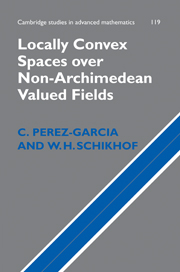Book contents
- Frontmatter
- Contents
- Preface
- 1 Ultrametrics and valuations
- 2 Normed spaces
- 3 Locally convex spaces
- 4 The Hahn–Banach Theorem
- 5 The weak topology
- 6 C-compactness
- 7 Barrelledness and reflexivity
- 8 Montel and nuclear spaces
- 9 Spaces with an “orthogonal” base
- 10 Tensor products
- 11 Inductive limits
- Appendix A Glossary of terms
- Appendix B Guide to the examples
- Notation
- References
- Index
7 - Barrelledness and reflexivity
Published online by Cambridge University Press: 06 July 2010
- Frontmatter
- Contents
- Preface
- 1 Ultrametrics and valuations
- 2 Normed spaces
- 3 Locally convex spaces
- 4 The Hahn–Banach Theorem
- 5 The weak topology
- 6 C-compactness
- 7 Barrelledness and reflexivity
- 8 Montel and nuclear spaces
- 9 Spaces with an “orthogonal” base
- 10 Tensor products
- 11 Inductive limits
- Appendix A Glossary of terms
- Appendix B Guide to the examples
- Notation
- References
- Index
Summary
We first follow the “classical” path by developing the notion of barrelledness, a key tool for the theory of reflexivity to be treated in Section 7.4. Indeed, we will prove (7.1.3) that Fréchet spaces are barrelled, by using the Baire Category Theorem.
Nevertheless, for a proper characterization of reflexivity (see 7.4.13) we need a modification of the notion of barrelledness by introducing the wider concept of “polar barrelledness” in 7.1.6. The fact that it is not identical to “ordinary” barrelledness (7.1.10) is a typical non-Archimedean feature. Despite of this, the proofs of the hereditary properties of (polar) barrelledness for quotients (7.1.12(i)), for locally convex direct sums and inductive limits (7.1.13), for products (7.1.15) and completions (7.1.17) are basically “classical”.
In the same spirit we introduce in Section 7.3 the weak star and strong topologies on the dual E′, define reflexivity in 7.4.1 and prove the characterization 7.4.13 of reflexivity. Products and locally convex direct sums of reflexive spaces are reflexive (7.4.23).
However, after this point our results are going to diverge from the classical ones; therefore, we mention a few facts.
For spherically complete K we show in 7.4.19 that every reflexive space is semi-Montel (i.e., each bounded set is a compactoid, see 8.4.1(i) and 8.4.5(δ)), so that reflexive Banach spaces are finite-dimensional. This is in contrast to 7.4.30 showing that every Fréchet space of countable type over a nonspherically complete K is reflexive.
If K is spherically complete, closed subspaces of reflexive Fréchet spaces are reflexive (7.4.27), but if K is not, the reflexive Banach space ℓ∞ contains a closed non-reflexive subspace (7.4.18(i)).
- Type
- Chapter
- Information
- Locally Convex Spaces over Non-Archimedean Valued Fields , pp. 254 - 300Publisher: Cambridge University PressPrint publication year: 2010

